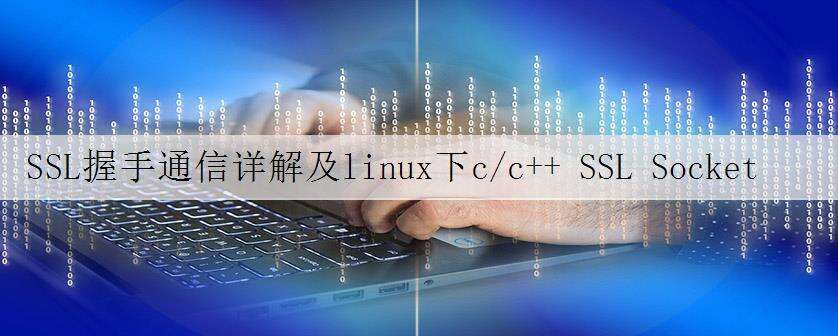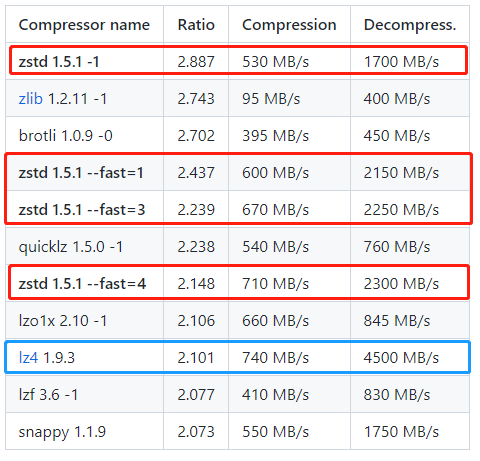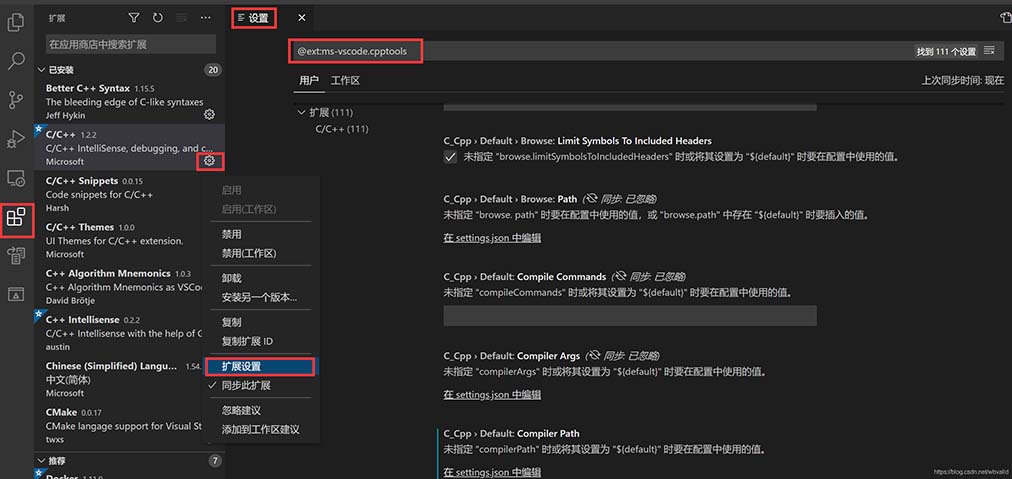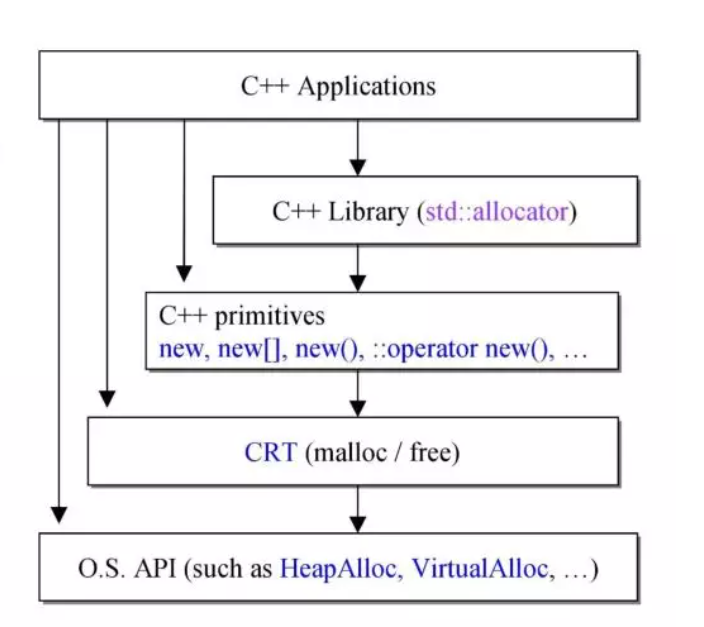SSL握手通信详解及linux下c/c++ SSL Socket代码举例(另附SSL双向认证客户端代码)摘自: https://blog.csdn.net/sjin_1314/article/details/210436132014年03月11日 22:02:14?轻飘风扬?阅读数:19886?SSL(Secure So...

SSL握手通信详解及linux下c/c++ SSL Socket代码举例(另附SSL双向认证客户端代码)
摘自: https://blog.csdn.net/sjin_1314/article/details/21043613
2014年03月11日 22:02:14?轻飘风扬?阅读数:19886
?
SSL(Secure Sockets Layer 安全套接层),及其继任者传输层安全(Transport Layer Security,TLS)是为网络通信提供安全及数据完整性的一种安全协议。TLS与SSL在传输层对网络连接进行加密。
安全证书既包含了用于加密数据的密钥,又包含了用于证实身份的数字签名。安全证书采用公钥加密技术。公钥加密是指使用一对非对称的密钥进行加密或解密。每一对密钥由公钥和私钥组成。公钥被广泛发布。私钥是隐秘的,不公开。用公钥加密的数据只能够被私钥解密。反过来,使用私钥加密的数据只能被公钥解密。这个非对称的特性使得公钥加密很有用。在安全证书中包含着一对非对称的密钥。只有安全证书的所有者才知道私钥。当通信方A将自己的安全证书发送给通信方B时,实际上发给通信方B的是公开密钥,接着通信方B可以向通信方A发送用公钥加密的数据,只有通信方A才能使用私钥对数据进行解密,从而获得通信方B发送的原始数据。安全证书中的数字签名部分是通信方A的电子身份证。数字签名告诉通信方B该信息确实由通信方A发出,不是伪造的,也没有被篡改。
客户与服务器通信时,首先要进行SSL握手,SSL握手主要完成以下任务:
1)协商使用的加密套件。加密套件中包括一组加密参数,这些参数指定了加密算法和密钥的长度等信息。
2)验证对方的身份,此操作是可选的。
3)确定使用的加密算法。
4)SSL握手过程采用非对称加密方法传递数据,由此来建立一个安全的SSL会话。SSL握手完成后,通信双方将采用对称加密方法传递实际的应用数据。
以下是SSL握手的具体流程:
(1)客户将自己的SSL版本号、加密参数、与SSL会话有关的数据及其他一些必要信息发送到服务器。
(2)服务器将自己的SSL版本号、加密参数、与SSL会话有关的数据及其他一些必要信息发送给客户,同时发给客户的还有服务器的证书。如果服务器需要验证客户身份,服务器还会发出要求客户提供安全证书的请求。
(3)客户端验证服务器证书,如果验证失败,就提示不能建立SSL连接。如果成功,那么继续下一步骤。
(4)客户端为本次SSL会话生成预备主密码(pre-master secret),并将其用服务器公钥加密后发送给服务器。
(5)如果服务器要求验证客户身份,客户端还要对另外一些数据签名后,将其与客户端证书一起发送给服务器。
(6)如果服务器要求验证客户身份,则检查签署客户证书的CA(Certificate Authority,证书机构)是否可信。如果不在信任列表中,结束本次会话。如果检查通过,服务器用自己的私钥解密收到的预备主密码(pre-master secret),并用它通过某些算法生成本次会话的主密码(master secret)。
(7)客户端与服务器端均使用此主密码(master secret)生成此次会话的会话密钥(对称密钥)。在双方SSL握手结束后传递任何消息均使用此会话密钥。这样做的主要原因是对称加密比非对称加密的运算量要低一个数量级以上,能够显著提高双方会话时的运算速度。
(8)客户端通知服务器此后发送的消息都使用这个会话密钥进行加密,并通知服务器客户端已经完成本次SSL握手。
(9)服务器通知客户端此后发送的消息都使用这个会话密钥进行加密,并通知客户端服务器已经完成本次SSL握手。
(10)本次握手过程结束,SSL会话已经建立。在接下来的会话过程中,双方使用同一个会话密钥分别对发送和接收的信息进行加密和解密。
以下为 linux c/c++ SSL socket Client和Server的代码参考。
-
/*File:client.c
-
*Auth:sjin
-
*Date:2014-03-11
-
*
-
*/
-
-
-
#include <stdio.h>
-
#include <string.h>
-
#include <errno.h>
-
#include <sys/socket.h>
-
#include <resolv.h>
-
#include <stdlib.h>
-
#include <netinet/in.h>
-
#include <arpa/inet.h>
-
#include <unistd.h>
-
#include <sys/types.h>
-
#include <sys/stat.h>
-
#include <fcntl.h>
-
#include <openssl/ssl.h>
-
#include <openssl/err.h>
-
-
#define MAXBUF 1024
-
-
void ShowCerts(SSL * ssl)
-
{
-
X509 *cert;
-
char *line;
-
-
cert = SSL_get_peer_certificate(ssl);
-
if (cert != NULL) {
-
printf("Digital certificate information:\n");
-
line = X509_NAME_oneline(X509_get_subject_name(cert), 0, 0);
-
printf("Certificate: %s\n", line);
-
free(line);
-
line = X509_NAME_oneline(X509_get_issuer_name(cert), 0, 0);
-
printf("Issuer: %s\n", line);
-
free(line);
-
X509_free(cert);
-
}
-
else
-
printf("No certificate information!\n");
-
}
-
-
int main(int argc, char **argv)
-
{
-
int i,j,sockfd, len, fd, size;
-
char fileName[50],sendFN[20];
-
struct sockaddr_in dest;
-
char buffer[MAXBUF + 1];
-
SSL_CTX *ctx;
-
SSL *ssl;
-
-
if (argc != 3)
-
{
-
printf("Parameter format error! Correct usage is as follows:\n\t\t%s IP Port\n\tSuch as:\t%s 127.0.0.1 80\n", argv[0], argv[0]); exit(0);
-
}
-
-
/* SSL 库初始化 */
-
SSL_library_init();
-
OpenSSL_add_all_algorithms();
-
SSL_load_error_strings();
-
ctx = SSL_CTX_new(SSLv23_client_method());
-
if (ctx == NULL)
-
{
-
ERR_print_errors_fp(stdout);
-
exit(1);
-
}
-
-
/* 创建一个 socket 用于 tcp 通信 */
-
if ((sockfd = socket(AF_INET, SOCK_STREAM, 0)) < 0)
-
{
-
perror("Socket");
-
exit(errno);
-
}
-
printf("socket created\n");
-
-
/* 初始化服务器端(对方)的地址和端口信息 */
-
bzero(&dest, sizeof(dest));
-
dest.sin_family = AF_INET;
-
dest.sin_port = htons(atoi(argv[2]));
-
if (inet_aton(argv[1], (struct in_addr *) &dest.sin_addr.s_addr) == 0)
-
{
-
perror(argv[1]);
-
exit(errno);
-
}
-
printf("address created\n");
-
-
/* 连接服务器 */
-
if (connect(sockfd, (struct sockaddr *) &dest, sizeof(dest)) != 0)
-
{
-
perror("Connect ");
-
exit(errno);
-
}
-
printf("server connected\n\n");
-
-
/* 基于 ctx 产生一个新的 SSL */
-
ssl = SSL_new(ctx);
-
SSL_set_fd(ssl, sockfd);
-
/* 建立 SSL 连接 */
-
if (SSL_connect(ssl) == -1)
-
ERR_print_errors_fp(stderr);
-
else
-
{
-
printf("Connected with %s encryption\n", SSL_get_cipher(ssl));
-
ShowCerts(ssl);
-
}
-
-
/* 接收用户输入的文件名,并打开文件 */
-
printf("\nPlease input the filename of you want to load :\n>");
-
scanf("%s",fileName);
-
if((fd = open(fileName,O_RDONLY,0666))<0)
-
{
-
perror("open:");
-
exit(1);
-
}
-
-
/* 将用户输入的文件名,去掉路径信息后,发给服务器 */
-
for(i=0;i<=strlen(fileName);i++)
-
{
-
if(fileName[i]=='/')
-
{
-
j=0;
-
continue;
-
}
-
else {sendFN[j]=fileName[i];++j;}
-
}
-
len = SSL_write(ssl, sendFN, strlen(sendFN));
-
if (len < 0)
-
printf("'%s'message Send failure !Error code is %d,Error messages are '%s'\n", buffer, errno, strerror(errno));
-
-
/* 循环发送文件内容到服务器 */
-
bzero(buffer, MAXBUF + 1);
-
while((size=read(fd,buffer,1024)))
-
{
-
if(size<0)
-
{
-
perror("read:");
-
exit(1);
-
}
-
else
-
{
-
len = SSL_write(ssl, buffer, size);
-
if (len < 0)
-
printf("'%s'message Send failure !Error code is %d,Error messages are '%s'\n", buffer, errno, strerror(errno));
-
}
-
bzero(buffer, MAXBUF + 1);
-
}
-
printf("Send complete !\n");
-
-
/* 关闭连接 */
-
close(fd);
-
SSL_shutdown(ssl);
-
SSL_free(ssl);
-
close(sockfd);
-
SSL_CTX_free(ctx);
-
return 0;
-
}
-
/*File:server.c
-
*Auth:sjin
-
*Date:2014-03-11
-
*
-
*/
-
#include <stdio.h>
-
#include <stdlib.h>
-
#include <errno.h>
-
#include <string.h>
-
#include <sys/types.h>
-
#include <netinet/in.h>
-
#include <sys/socket.h>
-
#include <sys/wait.h>
-
#include <unistd.h>
-
#include <arpa/inet.h>
-
#include <sys/types.h>
-
#include <sys/stat.h>
-
#include <fcntl.h>
-
#include <openssl/ssl.h>
-
#include <openssl/err.h>
-
-
#define MAXBUF 1024
-
-
int main(int argc, char **argv)
-
{
-
int sockfd, new_fd, fd;
-
socklen_t len;
-
struct sockaddr_in my_addr, their_addr;
-
unsigned int myport, lisnum;
-
char buf[MAXBUF + 1];
-
char new_fileName[50]="/newfile/";
-
SSL_CTX *ctx;
-
mode_t mode;
-
char pwd[100];
-
char* temp;
-
-
/* 在根目录下创建一个newfile文件夹 */
-
mkdir("/newfile",mode);
-
-
if (argv[1])
-
myport = atoi(argv[1]);
-
else
-
{
-
myport = 7838;
-
argv[2]=argv[3]=NULL;
-
}
-
-
if (argv[2])
-
lisnum = atoi(argv[2]);
-
else
-
{
-
lisnum = 2;
-
argv[3]=NULL;
-
}
-
-
/* SSL 库初始化 */
-
SSL_library_init();
-
/* 载入所有 SSL 算法 */
-
OpenSSL_add_all_algorithms();
-
/* 载入所有 SSL 错误消息 */
-
SSL_load_error_strings();
-
/* 以 SSL V2 和 V3 标准兼容方式产生一个 SSL_CTX ,即 SSL Content Text */
-
ctx = SSL_CTX_new(SSLv23_server_method());
-
/* 也可以用 SSLv2_server_method() 或 SSLv3_server_method() 单独表示 V2 或 V3标准 */
-
if (ctx == NULL)
-
{
-
ERR_print_errors_fp(stdout);
-
exit(1);
-
}
-
/* 载入用户的数字证书, 此证书用来发送给客户端。 证书里包含有公钥 */
-
getcwd(pwd,100);
-
if(strlen(pwd)==1)
-
pwd[0]='\0';
-
if (SSL_CTX_use_certificate_file(ctx, temp=strcat(pwd,"/cacert.pem"), SSL_FILETYPE_PEM) <= 0)
-
{
-
ERR_print_errors_fp(stdout);
-
exit(1);
-
}
-
/* 载入用户私钥 */
-
getcwd(pwd,100);
-
if(strlen(pwd)==1)
-
pwd[0]='\0';
-
if (SSL_CTX_use_PrivateKey_file(ctx, temp=strcat(pwd,"/privkey.pem"), SSL_FILETYPE_PEM) <= 0)
-
{
-
ERR_print_errors_fp(stdout);
-
exit(1);
-
}
-
/* 检查用户私钥是否正确 */
-
if (!SSL_CTX_check_private_key(ctx))
-
{
-
ERR_print_errors_fp(stdout);
-
exit(1);
-
}
-
-
/* 开启一个 socket 监听 */
-
if ((sockfd = socket(PF_INET, SOCK_STREAM, 0)) == -1)
-
{
-
perror("socket");
-
exit(1);
-
}
-
else
-
printf("socket created\n");
-
-
bzero(&my_addr, sizeof(my_addr));
-
my_addr.sin_family = PF_INET;
-
my_addr.sin_port = htons(myport);
-
if (argv[3])
-
my_addr.sin_addr.s_addr = inet_addr(argv[3]);
-
else
-
my_addr.sin_addr.s_addr = INADDR_ANY;
-
-
if (bind(sockfd, (struct sockaddr *) &my_addr, sizeof(struct sockaddr)) == -1)
-
{
-
perror("bind");
-
exit(1);
-
}
-
else
-
printf("binded\n");
-
-
if (listen(sockfd, lisnum) == -1)
-
{
-
perror("listen");
-
exit(1);
-
}
-
else
-
printf("begin listen\n");
-
-
while (1)
-
{
-
SSL *ssl;
-
len = sizeof(struct sockaddr);
-
/* 等待客户端连上来 */
-
if ((new_fd = accept(sockfd, (struct sockaddr *) &their_addr, &len)) == -1)
-
{
-
perror("accept");
-
exit(errno);
-
}
-
else
-
printf("server: got connection from %s, port %d, socket %d\n", inet_ntoa(their_addr.sin_addr), ntohs(their_addr.sin_port), new_fd);
-
-
/* 基于 ctx 产生一个新的 SSL */
-
ssl = SSL_new(ctx);
-
/* 将连接用户的 socket 加入到 SSL */
-
SSL_set_fd(ssl, new_fd);
-
/* 建立 SSL 连接 */
-
if (SSL_accept(ssl) == -1)
-
{
-
perror("accept");
-
close(new_fd);
-
break;
-
}
-
-
/* 接受客户端所传文件的文件名并在特定目录创建空文件 */
-
bzero(buf, MAXBUF + 1);
-
bzero(new_fileName+9, 42);
-
len = SSL_read(ssl, buf, MAXBUF);
-
if(len == 0)
-
printf("Receive Complete !\n");
-
else if(len < 0)
-
printf("Failure to receive message ! Error code is %d,Error messages are '%s'\n", errno, strerror(errno));
-
if((fd = open(strcat(new_fileName,buf),O_CREAT | O_TRUNC | O_RDWR,0666))<0)
-
{
-
perror("open:");
-
exit(1);
-
}
-
-
/* 接收客户端的数据并写入文件 */
-
while(1)
-
{
-
bzero(buf, MAXBUF + 1);
-
len = SSL_read(ssl, buf, MAXBUF);
-
if(len == 0)
-
{
-
printf("Receive Complete !\n");
-
break;
-
}
-
else if(len < 0)
-
{
-
printf("Failure to receive message ! Error code is %d,Error messages are '%s'\n", errno, strerror(errno));
-
exit(1);
-
}
-
if(write(fd,buf,len)<0)
-
{
-
perror("write:");
-
exit(1);
-
}
-
}
-
-
/* 关闭文件 */
-
close(fd);
-
/* 关闭 SSL 连接 */
-
SSL_shutdown(ssl);
-
/* 释放 SSL */
-
SSL_free(ssl);
-
/* 关闭 socket */
-
close(new_fd);
-
}
-
-
/* 关闭监听的 socket */
-
close(sockfd);
-
/* 释放 CTX */
-
SSL_CTX_free(ctx);
-
return 0;
-
}
Openssl双向认证客户端代码
openssl是一个功能丰富且自包含的开源安全工具箱。它提供的主要功能有:SSL协议实现(包括SSLv2、SSLv3和TLSv1)、大量软算法(对称/非对称/摘要)、大数运算、非对称算法密钥生成、ASN.1编解码库、证书请求(PKCS10)编解码、数字证书编解码、CRL编解码、OCSP协议、数字证书验证、PKCS7标准实现和PKCS12个人数字证书格式实现等功能。
本文主要介绍openssl进行客户端-服务器双向验证的通信,客户端应该如何设置。包括了如何使用openssl指令生成客户端-服务端的证书和密钥,以及使用openssl自带server端来实现简单的ssl双向认证,client端代码中也做了相应的标注和说明,提供编译的Makefile.希望对开始学习如何使用openssl进行安全连接的朋友有益。
1. 首先介绍如何生成客户和服务端证书(PEM)及密钥。
在linux环境下下载并安装openssl开发包后,通过openssl命令来建立一个SSL测试环境。
1) 建立自己的CA
在openssl安装目录的misc目录下,运行脚本:./CA.sh -newca,出现提示符时,直接回车。 运行完毕后会生成一个demonCA的目录,里面包含了ca证书及其私钥。
2) 生成客户端和服务端证书申请:
openssl req -newkey rsa:1024 -out req1.pem -keyout sslclientkey.pem
openssl req -newkey rsa:1024 -out req2.pem -keyout sslserverkey.pem
3) 签发客户端和服务端证书
openssl ca -in req1.pem -out sslclientcert.pem
openssl ca -in req2.pem -out sslservercert.pem
4) 运行ssl服务端:
openssl s_server -cert sslservercert.pem -key sslserverkey.pem -CAfile demoCA/cacert.pem -ssl3
当然我们也可以使用openssl自带的客户端:
openssl s_client -ssl3 -CAfile demoCA/cacert.pem
但这里我们为了介绍client端的设置过程,还是从一下代码来看看如何书写吧。
-
#include <openssl/ssl.h>
-
#include <openssl/crypto.h>
-
#include <openssl/err.h>
-
#include <openssl/bio.h>
-
#include <openssl/pkcs12.h>
-
-
#include <unistd.h>
-
#include <stdio.h>
-
#include <string.h>
-
#include <stdlib.h>
-
#include <errno.h>
-
#include <sys/socket.h>
-
#include <sys/types.h>
-
#include <netinet/in.h>
-
#include <arpa/inet.h>
-
-
#define IP "172.22.14.157"
-
#define PORT 4433
-
#define CERT_PATH "./sslclientcert.pem"
-
#define KEY_PATH "./sslclientkey.pem"
-
#define CAFILE "./demoCA/cacert.pem"
-
static SSL_CTX *g_sslctx = NULL;
-
-
-
int connect_to_server(int fd ,char* ip,int port){
-
struct sockaddr_in svr;
-
memset(&svr,0,sizeof(svr));
-
svr.sin_family = AF_INET;
-
svr.sin_port = htons(port);
-
if(inet_pton(AF_INET,ip,&svr.sin_addr) <= 0){
-
printf("invalid ip address!\n");
-
return -1;
-
}
-
if(connect(fd,(struct sockaddr *)&svr,sizeof(svr))){
-
printf("connect error : %s\n",strerror(errno));
-
return -1;
-
}
-
-
return 0;
-
}
-
-
//客户端证书内容输出
-
void print_client_cert(char* path)
-
{
-
X509 *cert =NULL;
-
FILE *fp = NULL;
-
fp = fopen(path,"rb");
-
//从证书文件中读取证书到x509结构中,passwd为1111,此为生成证书时设置的
-
cert = PEM_read_X509(fp, NULL, NULL, "1111");
-
X509_NAME *name=NULL;
-
char buf[8192]={0};
-
BIO *bio_cert = NULL;
-
//证书持有者信息
-
name = X509_get_subject_name(cert);
-
X509_NAME_oneline(name,buf,8191);
-
printf("ClientSubjectName:%s\n",buf);
-
memset(buf,0,sizeof(buf));
-
bio_cert = BIO_new(BIO_s_mem());
-
PEM_write_bio_X509(bio_cert, cert);
-
//证书内容
-
BIO_read( bio_cert, buf, 8191);
-
printf("CLIENT CERT:\n%s\n",buf);
-
if(bio_cert)BIO_free(bio_cert);
-
fclose(fp);
-
if(cert) X509_free(cert);
-
}
-
//在SSL握手时,验证服务端证书时会被调用,res返回值为1则表示验证成功,否则为失败
-
static int verify_cb(int res, X509_STORE_CTX *xs)
-
{
-
printf("SSL VERIFY RESULT :%d\n",res);
-
switch (xs->error)
-
{
-
case X509_V_ERR_UNABLE_TO_GET_CRL:
-
printf(" NOT GET CRL!\n");
-
return 1;
-
default :
-
break;
-
}
-
return res;
-
}
-
-
int sslctx_init()
-
{
-
#if 0
-
BIO *bio = NULL;
-
X509 *cert = NULL;
-
STACK_OF(X509) *ca = NULL;
-
EVP_PKEY *pkey =NULL;
-
PKCS12* p12 = NULL;
-
X509_STORE *store =NULL;
-
int error_code =0;
-
#endif
-
-
int ret =0;
-
print_client_cert(CERT_PATH);
-
//registers the libssl error strings
-
SSL_load_error_strings();
-
-
//registers the available SSL/TLS ciphers and digests
-
SSL_library_init();
-
-
//creates a new SSL_CTX object as framework to establish TLS/SSL
-
g_sslctx = SSL_CTX_new(SSLv23_client_method());
-
if(g_sslctx == NULL){
-
ret = -1;
-
goto end;
-
}
-
-
//passwd is supplied to protect the private key,when you want to read key
-
SSL_CTX_set_default_passwd_cb_userdata(g_sslctx,"1111");
-
-
//set cipher ,when handshake client will send the cipher list to server
-
SSL_CTX_set_cipher_list(g_sslctx,"HIGH:MEDIA:LOW:!DH");
-
//SSL_CTX_set_cipher_list(g_sslctx,"AES128-SHA");
-
-
//set verify ,when recive the server certificate and verify it
-
//and verify_cb function will deal the result of verification
-
SSL_CTX_set_verify(g_sslctx, SSL_VERIFY_PEER, verify_cb);
-
-
//sets the maximum depth for the certificate chain verification that shall
-
//be allowed for ctx
-
SSL_CTX_set_verify_depth(g_sslctx, 10);
-
-
//load the certificate for verify server certificate, CA file usually load
-
SSL_CTX_load_verify_locations(g_sslctx,CAFILE, NULL);
-
-
//load user certificate,this cert will be send to server for server verify
-
if(SSL_CTX_use_certificate_file(g_sslctx,CERT_PATH,SSL_FILETYPE_PEM) <= 0){
-
printf("certificate file error!\n");
-
ret = -1;
-
goto end;
-
}
-
//load user private key
-
if(SSL_CTX_use_PrivateKey_file(g_sslctx,KEY_PATH,SSL_FILETYPE_PEM) <= 0){
-
printf("privatekey file error!\n");
-
ret = -1;
-
goto end;
-
}
-
if(!SSL_CTX_check_private_key(g_sslctx)){
-
printf("Check private key failed!\n");
-
ret = -1;
-
goto end;
-
}
-
-
end:
-
return ret;
-
}
-
-
void sslctx_release()
-
{
-
EVP_cleanup();
-
if(g_sslctx){
-
SSL_CTX_free(g_sslctx);
-
}
-
g_sslctx= NULL;
-
}
-
//打印服务端证书相关内容
-
void print_peer_certificate(SSL *ssl)
-
{
-
X509* cert= NULL;
-
X509_NAME *name=NULL;
-
char buf[8192]={0};
-
BIO *bio_cert = NULL;
-
//获取server端证书
-
cert = SSL_get_peer_certificate(ssl);
-
//获取证书拥有者信息
-
name = X509_get_subject_name(cert);
-
X509_NAME_oneline(name,buf,8191);
-
printf("ServerSubjectName:%s\n",buf);
-
memset(buf,0,sizeof(buf));
-
bio_cert = BIO_new(BIO_s_mem());
-
PEM_write_bio_X509(bio_cert, cert);
-
BIO_read( bio_cert, buf, 8191);
-
//server证书内容
-
printf("SERVER CERT:\n%s\n",buf);
-
if(bio_cert)BIO_free(bio_cert);
-
if(cert)X509_free(cert);
-
}
-
-
int main(int argc, char** argv){
-
int fd = -1 ,ret = 0;
-
SSL *ssl = NULL;
-
char buf[1024] ={0};
-
//初始化SSL
-
if(sslctx_init()){
-
printf("sslctx init failed!\n");
-
goto out;
-
}
-
//客户端socket建立tcp连接
-
fd = socket(AF_INET,SOCK_STREAM,0);
-
if(fd < 0){
-
printf("socket error:%s\n",strerror(errno));
-
goto out;
-
}
-
-
if(connect_to_server(fd ,IP,PORT)){
-
printf("can't connect to server:%s:%d\n",IP,PORT);
-
goto out;
-
}
-
ssl = SSL_new(g_sslctx);
-
if(!ssl){
-
printf("can't get ssl from ctx!\n");
-
goto out;
-
}
-
SSL_set_fd(ssl,fd);
-
//建立与服务端SSL连接
-
ret = SSL_connect(ssl);
-
if(ret != 1){
-
int err = ERR_get_error();
-
printf("Connect error code: %d ,string: %s\n",err,ERR_error_string(err,NULL));
-
goto out;
-
}
-
//输入服务端证书内容
-
print_peer_certificate(ssl);
-
-
//SSL_write(ssl,"sslclient test!",strlen("sslclient test!"));
-
//SSL_read(ssl,buf,1024);
-
//关闭SSL连接
-
SSL_shutdown(ssl);
-
-
-
out:
-
if(fd >0)close(fd);
-
if(ssl != NULL){
-
SSL_free(ssl);
-
ssl = NULL;
-
}
-
if(g_sslctx != NULL) sslctx_release();
-
return 0;
-
}
参考资料:
http://www.169it.com/article/3215130236.html












